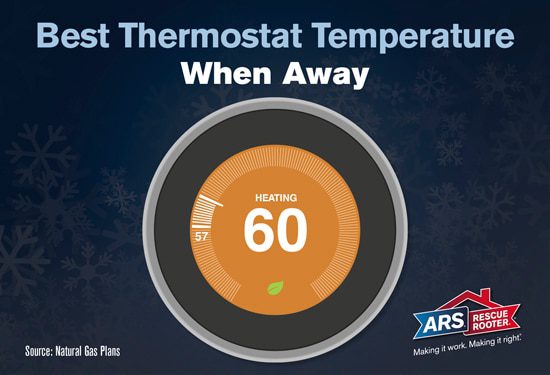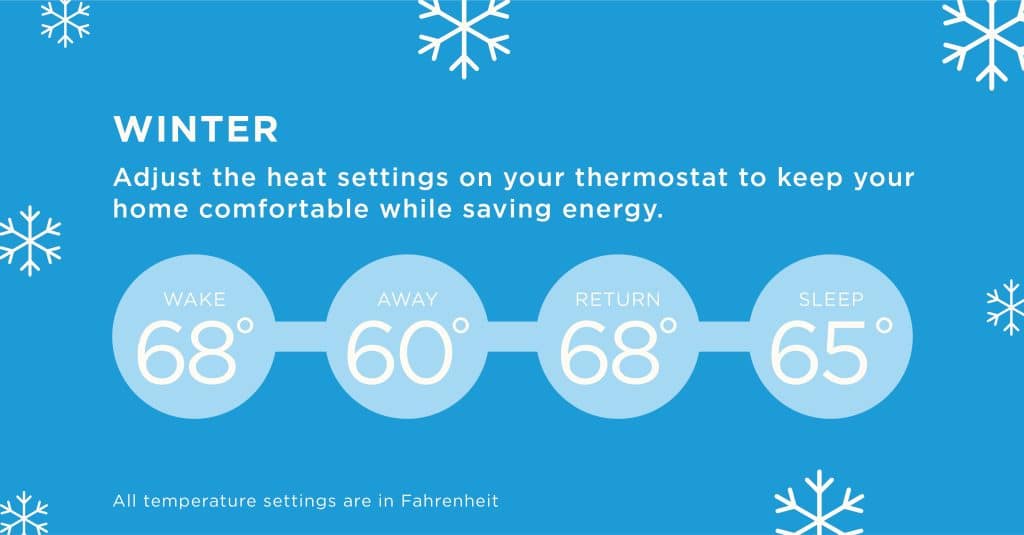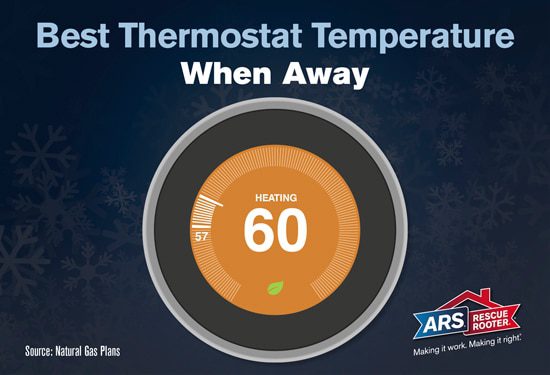Finding the ideal temperature for your house during the winter months can be challenging.
You want to stay comfortable and cozy but save money on your heating bill. So, what is the ideal house temperature in winter? It turns out there isn’t a one-size-fits-all answer.
Factors like personal preferences, insulation, and daily activities all play a role in determining the perfect temperature for your home.
This article will explore general guidelines to help you find the right balance between comfort and efficiency during the chilly winter season.
Review contents
Factors to Consider
When it comes to determining the ideal house temperature in winter, there are several factors that you should take into consideration.
These factors can significantly impact the comfort level of your home and help you maintain an optimal temperature throughout the season.
Insulation
One of the most important factors to consider is your home’s insulation. Proper insulation can make a significant difference in keeping your home warm during the winter months.
Good insulation helps to trap the heat inside, preventing it from escaping through the walls, floors, and ceilings. It also helps to keep cold drafts out, making your home more comfortable.
Building Materials
The materials used in the construction of your home can also play a role in determining the ideal temperature.
Some materials, such as brick or stone, can naturally retain heat. On the other hand, materials like metal or glass tend to conduct heat more efficiently and can make your home feel colder.
If you have a choice in selecting building materials, it’s worth considering the thermal properties of different options.
Geographical Location
The geographical location of your home can significantly impact the ideal house temperature in winter.
If you live in a region with frigid winters, you may need to maintain a higher temperature to keep your home comfortable.
Conversely, if you live in a milder climate, you may be able to lower the temperature slightly without sacrificing comfort.
It’s essential to consider the average outdoor temperature in your area, as this can guide you toward the appropriate indoor temperature.
Health and Comfort
Finally, it would be best to consider your health and comfort when determining the ideal house temperature in winter.
Some individuals may have underlying health conditions that require a warmer environment, while others may be more sensitive to the cold. Finding a temperature that allows you to feel comfortable and enjoy a healthy living environment is essential.
Recommended Temperatures
Now that we’ve considered the factors influencing the ideal winter house temperature, let’s explore some general guidelines. Remember that these are just recommendations, and personal preferences may vary.
General Guidelines
The general guideline for winter home temperatures is to set your thermostat to around 68°F (20°C) during the day when you’re at home.
This temperature is considered comfortable for most people and strikes a balance between warmth and energy efficiency. However, if this temperature is too cold or warm, adjust it according to your preferences.
Different Areas of the House
It’s important to note that the recommended temperature can vary depending on the specific area of your house.
For example, bedrooms can typically be slightly more fantastic at around 65°F (18°C), as cooler temperatures promote better sleep. On the other hand, living areas, such as the living room or kitchen, can be set to a slightly warmer temperature to provide a cozy atmosphere.
Energy Efficiency
Reducing energy costs is a concern for many homeowners, especially during winter. Here are some tips to help you improve energy efficiency while maintaining a comfortable temperature in your home.
Reducing Heating Costs
To keep your heating costs under control, it’s important to minimize heat loss. Ensure your home is adequately insulated, seal gaps or cracks, and consider upgrading to energy-efficient windows and doors.
Additionally, a programmable thermostat can help you create a heating schedule that aligns with your daily routine, saving energy when you’re not at home or night.
Smart Thermostats
A smart thermostat can provide even more significant energy savings and convenience. These thermostats learn your habits and adjust the temperature accordingly, optimizing energy usage.
They can also be controlled remotely through a smartphone app, allowing you to adjust the temperature from anywhere.
Zone Heating
Zone heating is another energy-efficient option to consider. Instead of heating the entire house, you can focus on heating only the areas that are being used.
This can be achieved by installing separate heating systems or using individual space heaters in different rooms. Zone heating allows you to customize the temperature in each area, maximizing comfort and reducing energy consumption.
Health and Comfort
In addition to energy efficiency, it’s essential to consider the health and comfort aspects of the house temperature in winter. Extreme cold or high temperatures can have adverse effects on your well-being. Maintaining a balanced and comfortable environment is critical.
Effects of Cold Temperatures
Exposure to cold temperatures for extended periods can lead to health issues such as hypothermia and frostbite. It can also exacerbate existing conditions like arthritis or respiratory problems.
Maintaining a warm temperature indoors is crucial to protect yourself and your family from these risks.
Effects of High Temperatures
While the primary concern in winter is staying warm, avoiding overheating your home is essential. Extremely high temperatures can cause dehydration, fatigue, and discomfort.
Finding a balance and setting a temperature that keeps you warm without exceeding what’s necessary is essential.
Balancing Temperature and Humidity
Maintaining an appropriate level of humidity is also essential for health and comfort. Dry air can cause dry skin, respiratory irritation, and static electricity.
On the other hand, excessive humidity can lead to mold growth and promote the spread of allergens. Using a humidifier or dehumidifier can help you achieve a comfortable humidity level in your home.
Thermostat Settings
To optimize the house temperature in winter, it’s essential to adjust your thermostat settings according to your lifestyle and needs. Here are some suggested settings for nighttime and vacation periods.
Nighttime Settings
While you sleep, you can lower the temperature slightly to save energy and promote better sleep.
Setting your thermostat to around 60-65°F (15-18°C) at night is generally recommended. Consider wearing additional blankets or warmer sleepwear if this temperature feels too cold.
Vacation Settings
When you’re away from home for an extended period, lowering the temperature is advisable to save energy. However, be careful not to set it too low, as frigid temperatures can cause issues like frozen pipes. Around 55-60°F (13-15°C) is typically suitable for vacations.
Tips for Maintaining an Ideal Temperature
In addition to thermostat adjustments, you can take several other steps to maintain an ideal temperature in your home during winter.
Regular Maintenance
Regular maintenance of your heating system is crucial to ensure optimal performance. Schedule professional inspections and cleanings to identify any issues and address them promptly. This will help prevent unexpected breakdowns and ensure that your system operates efficiently.
Insulation Improvements
If your home lacks proper insulation, consider improving it to reduce heat loss.
Adding insulation to your walls, attic, and floors can significantly enhance energy efficiency and maintain a comfortable temperature indoors. Insulation materials like fiberglass, cellulose, or spray foam can be used depending on your needs.
Window Coverings
Window coverings like curtains or blinds can serve as an additional insulation layer. Opening them during the day to allow sunlight to enter can help naturally heat your home. Keep them closed during the night to prevent heat loss through the windows.
Solar Heat Gain
Taking advantage of solar heat gain can be beneficial in keeping your home warmer. Ensure your windows allow sunlight to enter during the day by keeping them clean and unobstructed. Strategic landscaping with deciduous trees can provide summer shade while allowing winter sunlight.
Use of Fans
When it comes to maintaining an ideal temperature, fans can be your allies. In winter, ceiling fans can be set to rotate in a clockwise direction at a low speed.
This helps circulate warm air that rises to the ceiling and pushes it back towards the living areas.
Dealing with Drafts and Cold Spots
Drafts and cold spots can significantly affect the temperature and comfort of your home. Here are some tips to address these issues effectively.
Weatherstripping
Weatherstripping effectively seizes gaps around windows and doors, preventing drafts from entering your home. Self-adhesive weatherstrips are easy to install and can make a noticeable difference in minimizing heat loss and drafts.
Sealing Gaps and Cracks
Inspect your home for gaps or cracks that let cold air in. Apply caulk or sealant to seal these openings and prevent drafts. Common areas to check include electrical outlets, pipes, and vents. Pay attention to the areas where different building materials meet, as they can be prone to gaps.
Insulating Problem Areas
Identify any problem areas in your home prone to drafts or cold spots. These can include poorly insulated walls, attics, or basements. Consider adding insulation or using insulation blankets to improve the thermal performance of these areas.
Using Draft Stoppers
Draft stoppers, or draft snakes, can be placed at the base of doors or windows to prevent cold air from seeping in. They are typically made of fabric and filled with insulating material. They can be an inexpensive and effective way to block drafts, especially in older homes.
Special Considerations
While the general guidelines discussed above apply to most households, there are specific considerations to keep in mind for certain groups of individuals.
Infants and Young Children
Infants and young children may require a slightly warmer temperature to ensure comfort and safety. Maintaining a temperature between 68-72°F (20-22°C) for this age group is generally recommended. Be cautious not to overdress them or use heavy blankets, which can increase the risk of Sudden Infant Death Syndrome (SIDS).
Elderly Individuals
Elderly individuals are often more sensitive to changes in temperature and may require a warmer environment to stay comfortable. It’s essential to check on elderly family members or neighbors during cold weather and ensure they have the necessary heating.
Pets
Pets also need to be considered when setting the house temperature in winter. Most dogs and cats are comfortable with temperatures similar to humans, but some pets may have different needs. Consult with your veterinarian to determine your pet’s ideal temperature range.
Conclusion
Determining the ideal house temperature in winter is a personal consideration that involves balancing factors such as insulation, building materials, geographical location, and personal comfort.
By following general guidelines, prioritizing energy efficiency, considering health and comfort, and implementing practical tips, you can create a warm and comfortable living environment for you and your family during winter.
Remember to consider special considerations for infants, elderly individuals, and pets, ensuring their well-being and your own. Stay warm, stay comfortable, and enjoy the winter season in your cozy home.






































